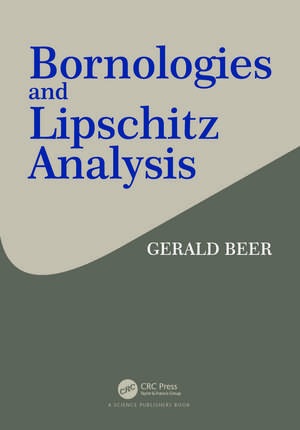Bornologies and Lipschitz Analysis
Autor Gerald Beeren Limba Engleză Paperback – 9 oct 2024
Classes of functions are intimately connected to various bornologies; e.g., (1) a function is locally Lipschitz if and only if its restriction to each relatively compact subset is Lipschitz; (2) a subset is Bourbaki bounded if and only if each uniformly continuous function on the space is bounded when restricted to the subset. A great deal of attention is given to the variational notions of strong uniform continuity and strong uniform convergence with respect to the members of a bornology, leading to the bornology of UC-subsets and UC-spaces. Spaces on which its uniformly continuous real-valued functions are stable under pointwise product are characterized in terms of the coincidence of the Bourbaki bounded subsets with a usually larger bornology.
Special attention is given to Lipschitz and locally Lipschitz functions. For example, uniformly dense subclasses of locally Lipschitz functions within the real-valued continuous functions, Cauchy continuous functions, and uniformly continuous functions are presented. It is shown very generally that a function between metric spaces has a particular metric property if and only if whenever it is followed in a composition by a real-valued Lipschitz function, the composition has the property. Bornological convergence of nets of closed subsets, having Attouch-Wets convergence as a prototype, is considered in detail. Topologies of uniform convergence for continuous linear operators between normed spaces is explained in terms of the bornological convergence of their graphs. Finally, the idea of a bornological extension of a topological space is presented, and all regular extensions can be so realized.
| Toate formatele și edițiile | Preț | Express |
|---|---|---|
| Paperback (1) | 435.77 lei 6-8 săpt. | |
| CRC Press – 9 oct 2024 | 435.77 lei 6-8 săpt. | |
| Hardback (1) | 682.07 lei 6-8 săpt. | |
| CRC Press – 27 apr 2023 | 682.07 lei 6-8 săpt. |
Preț: 435.77 lei
Nou
Puncte Express: 654
Preț estimativ în valută:
83.39€ • 90.55$ • 70.05£
83.39€ • 90.55$ • 70.05£
Carte tipărită la comandă
Livrare economică 23 aprilie-07 mai
Preluare comenzi: 021 569.72.76
Specificații
ISBN-13: 9780367498214
ISBN-10: 0367498219
Pagini: 242
Dimensiuni: 178 x 254 mm
Greutate: 0.44 kg
Ediția:1
Editura: CRC Press
Colecția CRC Press
Locul publicării:Boca Raton, United States
ISBN-10: 0367498219
Pagini: 242
Dimensiuni: 178 x 254 mm
Greutate: 0.44 kg
Ediția:1
Editura: CRC Press
Colecția CRC Press
Locul publicării:Boca Raton, United States
Public țintă
Academic and GeneralCuprins
Background material. Continuous functions on metric spaces. Extension of real-valued continuous functions on subsets of a metric space. The Arens-Eells theorem and the Hausdorff extension theorem. Nets and uniformities. Some basic bornologies. Total boundedness revisited and Bourbaki boundedness. Localy Lipschitz functions. Common sets of boundedness for classes of continuous functions. Hejcman’s theorem and its analog for totally bounded subsets. General constructions with bornologies. Properties of bornologies. Approximation by members of a bornology. Selected topological properties of the one-point extension. Bornologies of metrically bounded sets. Bornologies of totally bounded sets. Strong uniform continuity. UC-subsets. UC-spaces. Pointwise products of uniformly continuous real-valued functions. Strong uniform convergence on bornologies. Uniform convergence on totally bounded subsets. Where must each member of a class of locally Lipschitz functions be Lipschitz? Real-valued Lipschitz functions and classes of locally Lipschitz functions. Coarse maps on metrically convex spaces. Some density results. More on our 4 classes of locally Lipschitz functions. Real-valued functionals and bornologies. Uniformly paracompact subsets. Uniformly paracompact spaces and uniformly locally Lipschitz functions. Bornological convergence of nets of closed subsets. Attouch-Wets convergence. Topologies of uniform convergence on B(X,Y) and convergence of graphs. Bornological convergence and uniform convergence of distance functionals. Bornological convergence with respect to the compact bornology. When is bornological convergence topological? Uniformizability and metrizability. Ideals, bornologies and extensions. When is an extension bornological?
Notă biografică
Gerald Beer, PhD UCLA 1971 won the faculty prize for teaching assistants at UCLA. He was a full professor at California State University Los Angeles, where he won the Presidents Distinguished Professor Award. He has around 140 papers in refereed journals plus two books: (1) Applied Calculus for Business and Economics; (2) Topologies on Closed and Closed Convex Sets. He is on the editorial boards of The Journal of Convex Analysis and Set-Valued and Variational Analysis. In 1983-1984, he was a Fulbright Professor associated with the Mathematical Consortium of Manila, and in 1986, he was a National Academy of Sciences exchange scholar at the Bulgarian Academy of Sciences. He had visiting positions at the University of California, Davis, University of Minnesota, University of Milan, University of Salerno, University of Naples II, University of Limoges, University of Montpellier II, University of Perpignan, University of Complutense Madrid, Politecnica Valencia, UMH Elche, and Auckland Institute of Technology. A conference honoring Professor Beer was held in Varenna, Lake Como, Italy on his 65th birthday.
Descriere
Bornologies are a useful tool in studying problems in mathematical analysis and general topology. For example, they can be used to characterize those metric spaces on which the real-valued uniformly continuous functions are stable under pointwise products.
